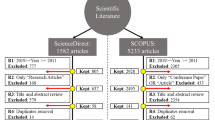Abstract
The manufacturing industry faces the challenge of responding quickly to the ever-changing requirements of customers. A key factor in these highly competitive environments is an ability for companies to master key production system dynamics such as change in the product types and variants and production quantities that they make, with high quality, low cost, and fast delivery. A novel approach to modelling manufacturing systems is introduced which is based on the provision of means for explicitly representing and computer executing dynamic producer units (DPUs). DPUs are defined as re-usable, change capable components of a manufacturing enterprise and have been described in the present authors’ previous publications. DPU concepts were conceived to support (1) the design of change capable manufacturing systems that can realise families of similar products in varying quantities and mixes and (2) the re-configuration of manufacturing systems in cases of withdrawal of a product family and introduction of a new one. To achieve this, a generic manufacturing system model is required to facilitate the systematic and timely alteration of production system designs and production plans. DPU modelling concepts facilitate these alterations through explicitly specifying the need for change capabilities so that rapid and cost-effective changeover responses can be made when production requirements change. This paper presents how DPU modelling concepts can be applied with reference to an industrial case study and describes a change decision-making framework in the form of a taxonomy and enabling tools.
Similar content being viewed by others
References
Angra S, Sehgal R, Samsudeen Noori Z (2008) Cellular manufacturing—a time based analysis to the layout problem. Int J Prod Econ 112(2008):427–438
Brehmer N, Wang C (1999) Reconfigurable manufacturing systems and environment consciousness, environmentally conscious design and inverse manufacturing. Proc EcoDesign 99:463–468
Childerhouse P, Towill D (2000) Engineering supply chains to match customer requirements. Logistics Inf Manage 13(6):337–346. doi:10.1108/09576050010355635
Cui Z, Weston RH (2008) Model driven engineering of economy of scope systems. Advanced design and manufacture to gain a competitive edge. Springer-Verlag, London, UK, pp 697–706
DeVor R, Graves R, Mills JJ (1997) Agile manufacturing research: accomplishments and opportunities. IIE Trans 29(10):813–823
Elmaraghy HA (2006) Flexible and reconfigurable manufacturing systems paradigms. Int J Flex Manuf Syst 17:261–276. doi:10.1007/s10696-006-9028-7
Standards ESPIRIT-CIMOSA (1993) CIMOSA: open system architecture for CIM. Springer, New York
Feitzinger E, Lee HL (1997) Mass customisation at Hewlett-Packard: the power of postponement. Harv Bus Rev 75(1):116–121
Gunasekaran A (1998) Agile manufacturing: enablers and an implementation framework. Int J Prod Res 36(5):1223–1247. doi:10.1080/002075498193291
Gupta YP, Goyal S (1989) Flexibility of manufacturing systems: concepts and measurements. Eur J Oper Res 22(5):119–135. doi:10.1016/0377-2217(89)90206-3
Harrison R, Weston RH, West AA, Monfared RP (2001) J Eng Manuf 215(Part B2):217–231
Jiao J, Ma Q, Tseng MM (2003) Towards high value-added products and services: mass customization and beyond. Technovation 23(10):809–821, 2003
Kidd PT (1994) Agile manufacturing: forging new frontiers. Addison-Wesley, London
Koren Y, Jovane F, Heisel U, Moriwaki T, Pritschow G, Ulsoy G, VanBrussel H (1999) Reconfigurable manufacturing systems. CIRP Ann 48(2):6–12, 1999
Lim SH (1987) Flexible manufacturing systems and manufacturing flexibility in the UK. Int J Oper Prod Manage 7(6):44–54. doi:10.1108/eb054807
Oleson JD (1998) Pathways to agility: mass customization in action. Wiley, New York
Onuh SO, Hon KKB (2000) Integration of rapid prototyping technology into FMS for agile manufacturing. Integrated Manuf Syst 12(3):179–186. doi:10.1108/09576060110391138
Pine BJ (1993) Mass customization: the new frontier in business competition. Harvard Business School, Boston
Rahimifard A, Weston RH (2007) The enhanced use of enterprise and simulation modelling techniques to support factory changeability. Int J Comput Integr Manuf 20(4):307–328
Suresh NC, Kay J (1998) Group technology and cellular manufacturing: updated perspectives, group technology and cellular manufacturing—a state-of-the-art synthesis of research and practice. Kluwer Academic, Boston, pp 1–14
van Hoek RI (2000) The thesis of leagility revisited. Int J Agil Manag Syst 2(3):196–201
Vernadat FB (1996) Enterprise modelling and integration: principles and applications. Chapman & Hall, London
Vernadat FB (1999) Research agenda for agile manufacturing. Int J Agile Manage Syst 1(1):37–40. doi:10.1108/14654659910266709
Weston RH (1998) Integration infrastructure requirements for agile manufacturing systems. Proc Institution Mech Engineers-B 212(B6):423–437. doi:10.1243/0954405981515734
Weston RH (1999) Manufacturing business systems, current best practice. Graduate & postgraduate material, Wolfson School, Loughborough University, UK
Weston RH, Zhen M, Ajaefobi JO, Rahimifard A, Guerrero A, Masood T, Wahid B, Ding C (2007) Simulating dynamic behaviours in manufacturing organisations. Int. Conf. on Industrial Engineering & Systems Management, Beijing, China
Weston RH, Rahimifard A, Ajaefobi J, Cui Z (2009) On modelling reusable components of change-capable manufacturing systems. Proc Inst Mech Eng, B J Eng Manuf 223:313–336
Wohlers T (2004) Past, present and future of rapid prototyping. Int J Prod Dev 1(2):147–154. doi:10.1504/IJPD.2004.005710
Yang B, Burns ND, Backhouse CJ (2004) Management of uncertainty through postponement. Int J Prod Res 42(6):1049–1064. doi:10.1080/00207540310001631601
Author information
Authors and Affiliations
Corresponding author
Rights and permissions
About this article
Cite this article
Rahimifard, A., Weston, R.H. A resource-based modelling approach to support responsive manufacturing systems. Int J Adv Manuf Technol 45, 1197 (2009). https://doi.org/10.1007/s00170-009-2025-8
Received:
Accepted:
Published:
DOI: https://doi.org/10.1007/s00170-009-2025-8




